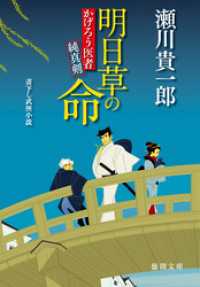- ホーム
- > 洋書
- > 英文書
- > History / World
Full Description
For generations, the original Snake River-Palouse people lived a free, open life on the Columbia Plateau, moving on horseback from the Snake River to Badger Mountain to Oregon's Blue Mountains. They interacted and intermarried within a vast region, and their stories are rich in content, interpretation, and nuance. Denied a place on their ancestral lands, most relocated to Nez Perce, Umatilla, Warm Springs, Yakama, and Colville reservations, where maintaining their cultural identity became increasingly difficult. Still, elders continued to pass down oral histories, insisting youngsters listen with rapt attention.Beginning in the 1970s, Naxiyamtáma elders--in particular Mary Jim, Andrew George, Gordon Fisher, and Emily Peone--shared their stories with a research team. They hoped to teach American Indian history in a traditional manner and refute incorrect versions. Multiple themes emerged--a pervasive spirituality tied to the Creator and environment; a covenant relationship and sacred trust to protect and preserve their traditional lands; storytelling as a revered art form that reveals life lessons; and finally, belief in cyclical time and blood memory.
Tied to Plateau people's leadership families, the featured elders had lived in the traditional way--gathering, hunting, and fishing, participating in the ancient Wáshani religion, and honoring the Creator through First Food ceremonies. In their retelling, the authors endeavored to capture their original voices and stay true to Snake River-Palouse oral traditions. Creation stories include "Why Coyote Made the Palouse Hills," and "The Origin of Palouse Falls." Although narratives by other groups are similar to Mary Jim's "How Coyote Learned to Fish," and Gordon Fisher's "How Beaver Brought Fire to the People," their versions offer a distinct Naxiyamtáma perspective. The authors also describe their method and approach--one that will serve as a model for conducting Native American cultural research.
Contents
List of MapsForeword by Carrie Jim Schuster
Preface
Notes on Lineages and Spelling
Introduction
PART I/Naxc: Mary Jim/Xinstanik
"Calling for Our Land"
"How Coyote Learned to Fish"
"The Creatures of Cloudy Mountain"
The Tílqawayks (Wolf) and Chowawatyet (Jim) Families
PART II/Napt: Andrew George/Tipiyelehne Xayxayx
"Nature is Our Teacher"
Chief Cleveland Kamiakin
"Salmon Man and the Wolf Brothers"
"Why Coyote Made the Palouse Hills"
The Kamiakin Family
PART III/Metad: Gordon Fisher/Yoosyoos Tulikecin
"Take Care of Mother Earth"
"How Beaver Brought Fire"
"The Origin of Palouse Falls"
The Poyakun/Billy Andrews and Paween Families
PART IV/Pinapt: Emily Friedlander Peone/Q'uomolah
"Too Many Memories"
Mary Owhi Moses/Sanclow
"Yamustas--Elk's Abode at Steptoe Butte"
"The Two Sisters and Star Brothers"
The Sulkstalk'scosm/Moses Family
PART V/Paxad: Landscapes of Beaver and Coyote
Appendix A: A Naxiyamtama Lexicon of Animal and Plant Terms
Appendix B: Historic Era Naxiyamtama Village and Place Names
Appendix C: Atinapam-Johnley Stories
Selected Bibliography
Index








